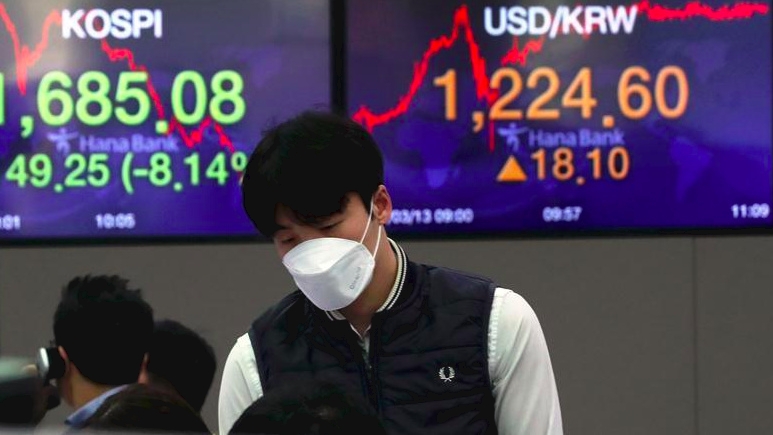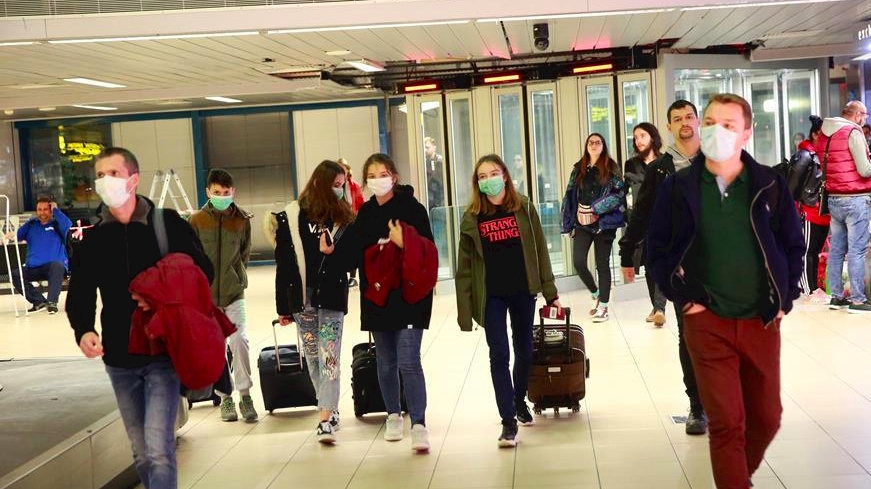
A staff member wearing face mask works at a trading hall of a bank in Seoul, South Korea, March 13, 2020. /Xinhua
Editor's Note: Daryl Guppy is a national board member of the Australia-China Business Council. He is the Australian representative with the Silk Road Chambers of International Commerce. He provides China policy advice and market intelligence to Government and business. He is also an international financial market technical analysis expert. The article reflects the author's opinions, and not necessarily the views of CGTN.
The Great Panic of 2020 is not the same as the Global Financial Crisis of 2008 (GFC) although some of the Great Panic collateral impacts will be similar. Governments are responding to the Great Panic as if it were a repeat of the GFC and these responses are most likely to be ineffective and may be more economically damaging than expected by supporting perverse outcomes.
The GFC was a liquidity and credit crisis. Banks stopped lending to each other and then stopped lending to customers. Without access to reasonable credit the wheels of industry and business soon seized up. The response included a reduction of interest rates, quantitative easing and Governments stepping in to provide credit as a last resort lender. We are still feeling the impacts of these credit policies and world economies remain more fragile in 2020 than they were going into 2008.
The appropriate response, led by China, was economic stimulus to maintain demand. China embarked on a massive infrastructure construction that helped to shield countries like Australia from the full impact of the GFC. Other countries followed with their own demand stimulus programs, backed by cheap money, to help expand the economy and preserve jobs in the face of a credit-induced slump in demand. This helicopter money, including direct gifts of money to people, was designed to stimulate demand and this was appropriate. The GFC was, in a very real sense, an economic problem that highlighted fundamental weaknesses in the business model.
The Great Panic presents very different core problems. This is not a credit crunch. This is not a demand slump. This is not a problem of the business model. The Great Panic is an emotive response to COVID-19 leading to quarantine action that impedes or closes down a generally healthy economy.

Passengers wearing face masks arrive at Henri Coanda International Airport in Bucharest, Romania, March 14, 2020. /Xinhua
Consider this from two perspectives – business and personal.
I have a thriving successful business. One of my staff gets COVID-19 so my doors are closed for two weeks. Or, as in Italy, I am forced to close my doors for two weeks.
I lose all my business income even though there is no reduction in the demand for my business. I cannot operate because my business has been suspended. It is a business hiatus.
However, I am still required to meet my standing costs of office rent, local and State taxes, payment for my staff who are forced to take leave through no fault of their own. I still must service my business loan.
I want to do business. I could do business because the demand is still there, and this is the essential difference between the GFC and the current situation. I cannot do business because the Great Panic has forced me to close for 14 days, and if more staff are infected with COVID-19 then that lockdown may be extended for another 14 days. The ongoing lengthy rolling quarantine lockdown with the Diamond Princess cruise ship in Japan is a leading example.
How long can my business survive without income? Possibly weeks but probably not months. I will not invest in capital equipment to get a tax break. My capital must be hoarded to meet ongoing business costs whilst my business is closed without income.
On a personal level the situation is also different from the GFC.
Although I am not sick, I am placed in a 14-day quarantine because someone in my office contracted COVID-19. I have cash to spend but I cannot spend it widely because the shops are closed. My spending is limited to food and Netflix entertainment. I cannot buy a new car or a dress. I cannot take my planned holiday, go to the cinema, or attend the conference. I cannot do these things that maintain or stimulate economic growth because I am locked in my home, or because these public events have been cancelled. I am trying to work from home, but being confined with a young child permanently home from school also makes this difficult.
An ever-present danger is that my employer will be forced to stop paying my wages as his business collapses.
In the Great Panic I am dis-employed – I have work, but cannot do it effectively because my office is in quarantine. In the GFC, people were unemployed so the challenge was to give them money so they could revitalize demand. The Great Panic is not a demand problem. In the Great Panic, it's less useful to give people money because they simply cannot spend in shops that are closed, or even if they are open, cannot deliver the purchases. They cannot travel to support the domestic tourism industry nor attend fee-paying universities because they are quarantine closed.
The Great Panic highlights another significant difference between Western and Chinese economies and that is the rate of household savings. China has a very high rate of personal savings. Western countries typically have a very low rate of savings. By many estimates, the average American family is less than two pay checks away from bankruptcy. Chinese families, on average, have significant higher saving rates.
Chinese families locked in extended quarantine used savings to fund their survival. Western families have limited ability to do this and will have to reach deeply into often already extended personal credit facilities to survive. In countries like Australia, they face additional burdens from ongoing high mortgage payments lingering from an overheated property market.
China survived the COVID-19 lockdown in part because of a well developed and sophisticated e-commerce structure based on advanced 5G and internet services. The shift to an almost fully digital economy only required a small bridging step because WePay and Alipay were already ubiquitous.
Western economies are not as advanced in these areas and this will hinder the ability of people under quarantine to fully satisfy their demand wishes. If your local food delivery service does not accept electronic payment and you have no cash to pay them, then your demand remains unfilled.
Western governments will continue to deploy inappropriate strategies until they acknowledge that the Great Panic is a beast of a very different nature to the GFC. The economy needs support to overcome the quarantine-induced business activity hiatus by reducing the cost burden on business survival such as tax holidays, suspension of government charges and fees and income support. The appropriate Great Panic response does not require demand and investment stimulus.
Grandma Ma's noodle shop doesn't benefit from a new freeway. Ms. Smith's service sector business doesn't need a new bridge over the river. Mr. Jones doesn't need tax breaks for expenditure on new equipment because he is too busy trying to survive an income drought. They all need capital relief from fees and charges so they can quickly restore business to meet existing demand after the COVID hiatus.
(Chongyang Institute for Financial Studies at Renmin University of China also contributed to this article.)
Source: CGTN







